Textural Characteristics and Anatomical Structure of Hard- and Soft-Fleshed Jujube Fruits
Abstract
1. Introduction
2. Materials and Methods
2.1. Overview of Study Area
2.2. Plant Materials
2.3. Test Methods
2.3.1. Determination of Physical Attributes of Jujube Fruit
2.3.2. Determination of the Intrinsic Quality Parameters of Jujube Fruit
2.3.3. Determination of Textural Characteristics of Jujube Fruit
2.3.4. Determination of Anatomical Structure of Jujube Fruit
2.4. Data Processing and Analysis
3. Results
3.1. Textural Characteristics of 56 Jujube Germplasms
3.2. Analysis of Characteristics of the Different-Textured Jujube Fruits
3.3. Analysis of External and Internal Quality of Different-Textured Jujube Fruits
3.4. Analysis of the Anatomical Structure of Different-Textured Jujube Fruits
3.5. Principal Component Analysis of Jujube Fruits
4. Discussion
5. Conclusions
Author Contributions
Funding
Institutional Review Board Statement
Data Availability Statement
Conflicts of Interest
References
- Zhou, X.; Shi, Q.; Li, X.; Yuan, Z.; Yan, M.; Lu, D.; Wang, Y.; Pu, X.; Wu, C. Study on the Metabolic Basis of the Color Formation of Two Color-Presenting Types of Jujube Fruits. Foods 2024, 13, 17. [Google Scholar] [CrossRef]
- Raffo, A.; Sinesio, F.; Moneta, E.; Nardo, N.; Peparaio, M.; Paoletti, F. Internal quality of fresh and cold stored celery petioles described by sensory profile, chemical and instrumental measurements. Eur. Food Res. Technol. 2006, 222, 590–599. [Google Scholar] [CrossRef]
- Parmar, N.; Singh, K.H.; Sharma, D.; Singh, L.; Kumar, P.; Nanjundan, J.; Khan, Y.J.; Chauhan, D.K.; Thakur, A.K. Genetic engineering strategies for biotic and abiotic stress tolerance and quality enhancement in horticultural crops: A comprehensive review. 3 Biotech 2017, 7, 239. [Google Scholar] [CrossRef]
- Qiu, X.; Zhang, H.; Zhang, H.; Duan, C.; Xiong, B.; Wang, Z. Fruit Textural Characteristics of 23 Plum (Prunus salicina Lindl) Cultivars: Evaluation and Cluster Analysis. Hortscience 2021, 56, 816–823. [Google Scholar] [CrossRef]
- Wang, Y.; Wang, X.; Guan, J. Flesh Texture Characteristic Analysis of Pear. Sci. Agric. Sin. 2014, 47, 4056–4066. [Google Scholar] [CrossRef]
- Jiang, X.; Wang, Y.; Yang, H.; Gao, Z.; Zhang, B.; Yang, Y.; Zhao, Z. Quantitative evaluation of fruit quality of apple hybrids. J. Northwest A F Univ. (Nat. Sci. Ed.) 2016, 44, 119–126. [Google Scholar] [CrossRef]
- Jackman, R.L.; Gibson, H.J.; Stanley, D.W. Effects of chilling on tomato fruit texture. Physiol. Plant. 2010, 86, 600–608. [Google Scholar] [CrossRef]
- An, X.; Li, Z.; Zude-Sasse, M.; Tchuenbou-Magaia, F.; Yang, Y. Characterization of textural failure mechanics of strawberry fruit. J. Food Eng. 2020, 282, 110016. [Google Scholar] [CrossRef]
- Chai, J.; Li, J.; Li, L.; Liao, B.; Liu, Z. 1-MCP application in ‘Xuxiang’ kiwifruit at appropriate firmness avoids hard-core and prolongs the shelf life. Postharvest Biol. Technol. 2023, 206, 112549. [Google Scholar] [CrossRef]
- Zuo, T.; Chen, H.; Yi, H.; Dong, M.; Huang, Y.; Wei, Z.; Yu, B.; Pan, H. Quality Evaluation and Analysis of Different Varieties of Valencia Orange. Chin. Agric. Sci. Bull. 2014, 30, 158–162. [Google Scholar]
- Ma, H.; Liu, Y.; Tu, X.; Deng, D.; Ye, J.; Yang, C.; Du, L.; Li, L. yunOptimization of Test Conditions for TPA Texture Properties of Avocado Flesh. IOP Conf. Ser. Earth Environ. Sci. 2020, 526, 12058. [Google Scholar] [CrossRef]
- Cao, X.; Bai, G.; Zheng, J.; Zhu, D.; Li, J. Effects of freeze-thaw cycles on the texture of Nanguo pear. J. Texture Stud. 2022, 53, 662–671. [Google Scholar] [CrossRef] [PubMed]
- Zhao, W.; Fang, Y.; Zhang, Q.; Guo, Y.; Gao, G.; Yi, X. Correlation analysis between chemical or texture attributes and stress relaxation properties of ‘Fuji’ apple. Postharvest Biol. Technol. 2017, 129, 45–51. [Google Scholar] [CrossRef]
- Kubra, O.; Ayse, K.; Osman, S.; Seyma, O.F.; Hayrettin, O. The effects of different drying methods on the sugar, organic acid, volatile composition, and textural properties of black ‘Isabel’ grape. J. Food Meas. Charact. 2022, 17, 1852–1861. [Google Scholar] [CrossRef]
- Ross, K.; DeLury, N.; Li, A.; Fukumoto, L.; Tiffin, K.Z. A Comparative Study of Five Apple Cultivars Linking Biochemical Changes at Different Developmental Stages with Storage Textural Quality. Horticulturae 2024, 10, 379. [Google Scholar] [CrossRef]
- Xu, Y.; Tian, L.; Cao, Y.; Dong, X.; Qi, D.; Huo, H. Evaluation and analysis of flesh texture of six pear varieties with different shelf life after cold storage. China Fruits 2024, 9, 14–23. [Google Scholar] [CrossRef]
- Ding, X.; Zheng, Y.; Jia, R.; Li, X.; Wang, B.; Zhao, Z. Comparison of Fruit Texture and Storage Quality of Four Apple Varieties. Foods 2024, 13, 10. [Google Scholar] [CrossRef]
- Kamal-Eldin, A.; George, N.; Sobti, B.; AlRashidi, N.; Ghnimi, S.; Ali, A.A.; Andersson, A.A.M.; Andersson, R.; Antony, A.; Hamed, F. Dietary fiber components, microstructure, and texture of date fruits (Phoenix dactylifera, L.). Sci. Rep. 2020, 10, 21767. [Google Scholar] [CrossRef]
- Blaker, K.M.; Olmstead, J.W. Cell wall composition of the skin and flesh tissue of crisp and standard texture southern highbush blueberry genotypes. J. Berry Res. 2015, 5, 9–15. [Google Scholar] [CrossRef]
- Goulao, L.F.; Santos, J.; de Sousa, I.; Oliveira, C.M. Patterns of enzymatic activity of cell wall-modifying enzymes during growth and ripening of apples. Postharvest Biol. Technol. 2006, 43, 307–318. [Google Scholar] [CrossRef]
- Peco, J.D.; Rapoport, H.F.; Centeno, A.; Pérez-López, D. Does Regulated Deficit Irrigation Affect Pear Fruit Texture by Modifying the Stone Cells? Plants 2023, 12, 4024. [Google Scholar] [CrossRef] [PubMed]
- Pan, H.; Li, M.; Liu, T.; Qi, H. Multi-microscopy techniques combined with FT-IR spectroscopy reveals the histological and biochemical causes leading to fruit texture difference in oriental melon (Cucumis melo var. Makuwa Makino). Food Chem. 2023, 402, 134229. [Google Scholar] [CrossRef]
- Yan, M.; Wang, Y.; Watharkar, R.B.; Pu, Y.; Wu, C.; Lin, M.; Lu, D.; Liu, M.; Bao, J.; Xia, Y. Physicochemical and antioxidant activity of fruit harvested from eight jujube (Ziziphus jujuba Mill.) cultivars at different development stages. Sci. Rep. 2022, 12, 2272. [Google Scholar] [CrossRef] [PubMed]
- Li, J. Study on molybdenum blue method of L-VC test by spectrometry. Food Sci. 2000, 21, 42–45. [Google Scholar]
- Kuang, Y.; Xu, Y.; Zhang, L.; Hou, E.; Shen, W. Dominant Trees in a Subtropical Forest Respond to Drought Mainly via Adjusting Tissue Soluble Sugar and Proline Content. Front. Plant Sci. 2017, 8, 802. [Google Scholar] [CrossRef]
- Pu, Y.; Ding, T.; Wang, W.; Xiang, Y.; Ye, X.; Li, M.; Liu, D. Effect of harvest, drying and storage on the bitterness, moisture, sugars, free amino acids and phenolic compounds of jujube fruit (Zizyphus jujuba cv. Junzao). J. Sci. Food Agric. 2018, 98, 628–634. [Google Scholar] [CrossRef]
- Pan, H.; Liu, D.; Shao, Q.; Gao, G.; Qi, H. Analysis and Comprehensive Evaluation of Textural Quality of Ripe Fruits from Different Varieties of Oriental Melon (Cucumis melo var. makuwa Makino). Food Sci. 2019, 40, 35–42. [Google Scholar]
- Yuan, Q.; Yang, S.; Qiao, S.; Ren, Y.; Zhou, J.; Zhang, X.; Chen, W.; Wan, Z.; Wei, T.; Xu, W.; et al. Changes in Pulp Texture and Anatomical Structure of ‘Lingwuchangzao’ (Ziziphus jujuba) during Fruit Development. Acta Agric. Boreali-Occident. Sin. 2024, 33, 851–861. [Google Scholar]
- Bejaei, M.; Cliff, M.A.; Singh, A. Multiple Correspondence and Hierarchical Cluster Analyses for the Profiling of Fresh Apple Customers Using Data from Two Marketplaces. Foods 2020, 9, 7. [Google Scholar] [CrossRef] [PubMed]
- Li, Q.; Tan, W.; Zhao, L.; Luo, H.; Zhou, Z.; Zhang, Y.; Bi, R.; Zhao, L. A Comprehensive Evaluation of 45 Pomegranate (Punica Granatum L.) Cultivars Based on Principal Component Analysis and Cluster Analysis. Int. J. Fruit Sci. 2023, 23, 135–150. [Google Scholar] [CrossRef]
- Hamdani, A.; Hssaini, L.; Bouda, S.; Adiba, A.; Razouk, R. Japanese plums behavior under water stress: Impact on yield and biochemical traits. Heliyon 2022, 8, e9278. [Google Scholar] [CrossRef] [PubMed]
- Zheng, P.; Zhang, M.; Wang, Z.; Wang, T.; Tang, L.; Ma, E.; Liu, J.; Shi, F. Comprehensive evaluation of the Fruit Quality of the Main Cultivars of Pear (Pyrus spp.) in North China. Erwerbs-Obstbau 2022, 64, 219–227. [Google Scholar] [CrossRef]
- Wei, T.; Dou, Y. Physiological-Biochemical Changes in Developing Jujube Fruits (Zizyphus jujuba Mill. cv. Lingwuchangzao). Chin. Agric. Sci. Bull. 2008, 4, 235–239. [Google Scholar]
- Jia, N.; Yin, Y.; Li, M.; Liu, C.; Han, B.; Sun, Y.; Zhao, S.; Guo, Z. Changes in fruit texture and anatomical structure of ‘Muscat Hamburg’ grapevines during ripening. J. China Agric. Univ. 2022, 27, 78–86. [Google Scholar]
- Johnston, J.W.; Hewett, E.W.; Hertog, M.L. Postharvest softening of apple (Malus domestica) fruit: A review. N. Z. J. Crop Hortic. Sci. 2002, 30, 145–160. [Google Scholar] [CrossRef]
- Zhang, C.; Fan, X.; Liu, C.; Fang, J. Anatomical berry characteristics during the development of grape berries with different shapes. Hortic. Plant J. 2021, 7, 295–306. [Google Scholar] [CrossRef]
- Lu, X.; He, N.; Anees, M.; Yang, D.; Kong, W.; Zhang, J.; Yuan, L.; Luo, X.; Zhu, H.; Liu, W. A Comparison of Watermelon Flesh Texture across Different Ploidy Levels Using Histology and Cell Wall Measurements. Horticulturae 2024, 10, 112. [Google Scholar] [CrossRef]
- Bai, M.; Liu, X.; Yang, S.; Hao, G.; Zhang, X.; Wang, Y.; Fu, B. Correlation with Cell Wall Metabolizing-related Enzymes and Microstructure Observation in Texture Differences of two Kinds of High-Quality Pear Fruit. Fujian J. Agric. Sci. 2023, 38, 917–923. [Google Scholar] [CrossRef]
- Yang, Z.; Wang, Z. Evaluation and Cluster Analysis of Jujube Fruit Texture Based on TPA Method. Xinjiang Agric. Sci. 2019, 56, 1860–1868. [Google Scholar]
- Nowicka, P.; Wojdyło, A.; Laskowski, P. Principal component analysis (PCA) of physicochemical compounds’ content in different cultivars of peach fruits, including qualification and quantification of sugars and organic acids by HPLC. Eur. Food Res. Technol. 2019, 245, 929–938. [Google Scholar] [CrossRef]
- Zhao, L.; Yan, S.; Wang, Y.; Xu, G.; Zhao, D. Evaluation of the Effect of Preharvest Melatonin Spraying on Fruit Quality of ‘Yuluxiang’ Pear Based on Principal Component Analysis. Foods 2023, 12, 3507. [Google Scholar] [CrossRef] [PubMed]
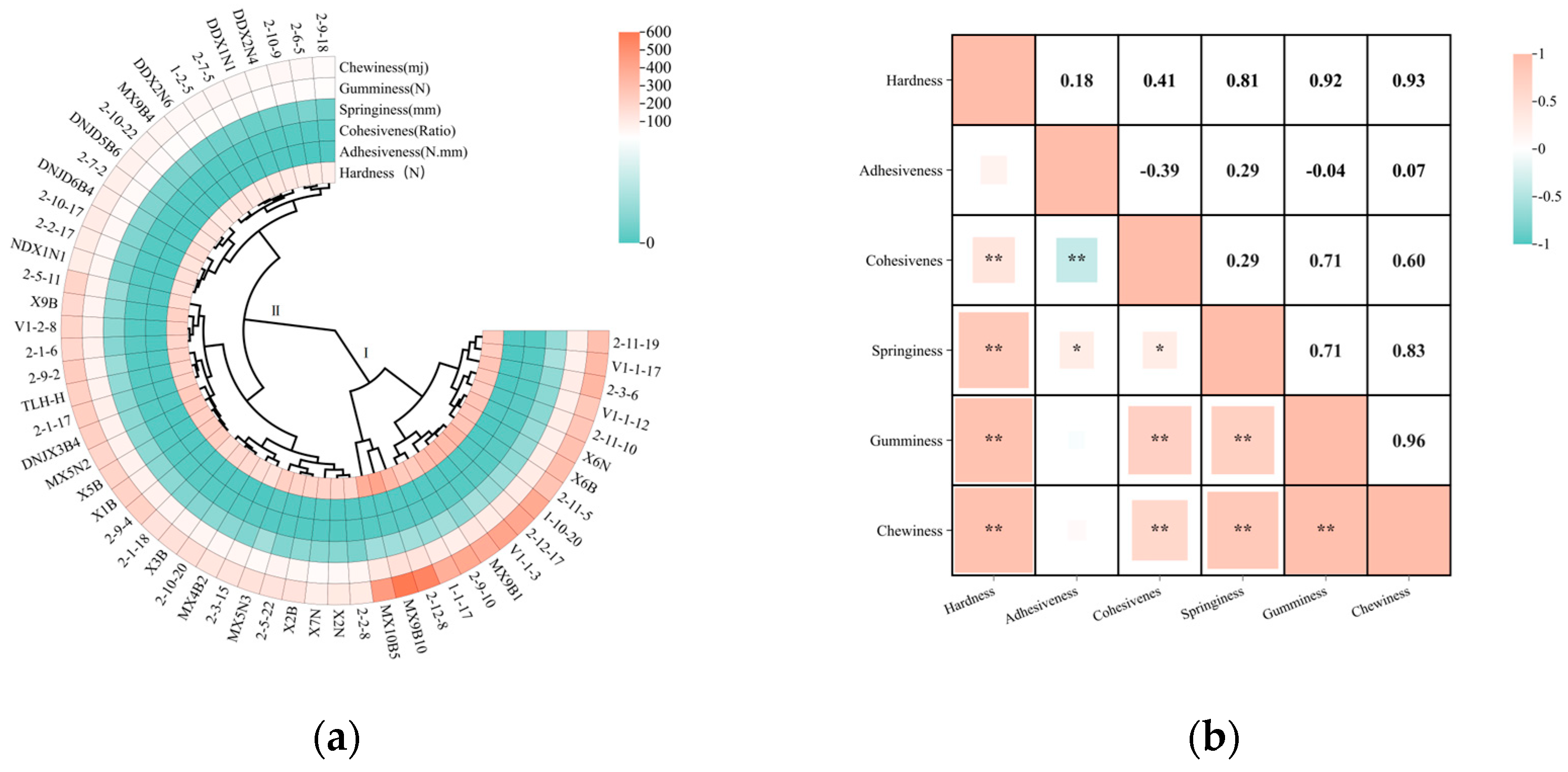
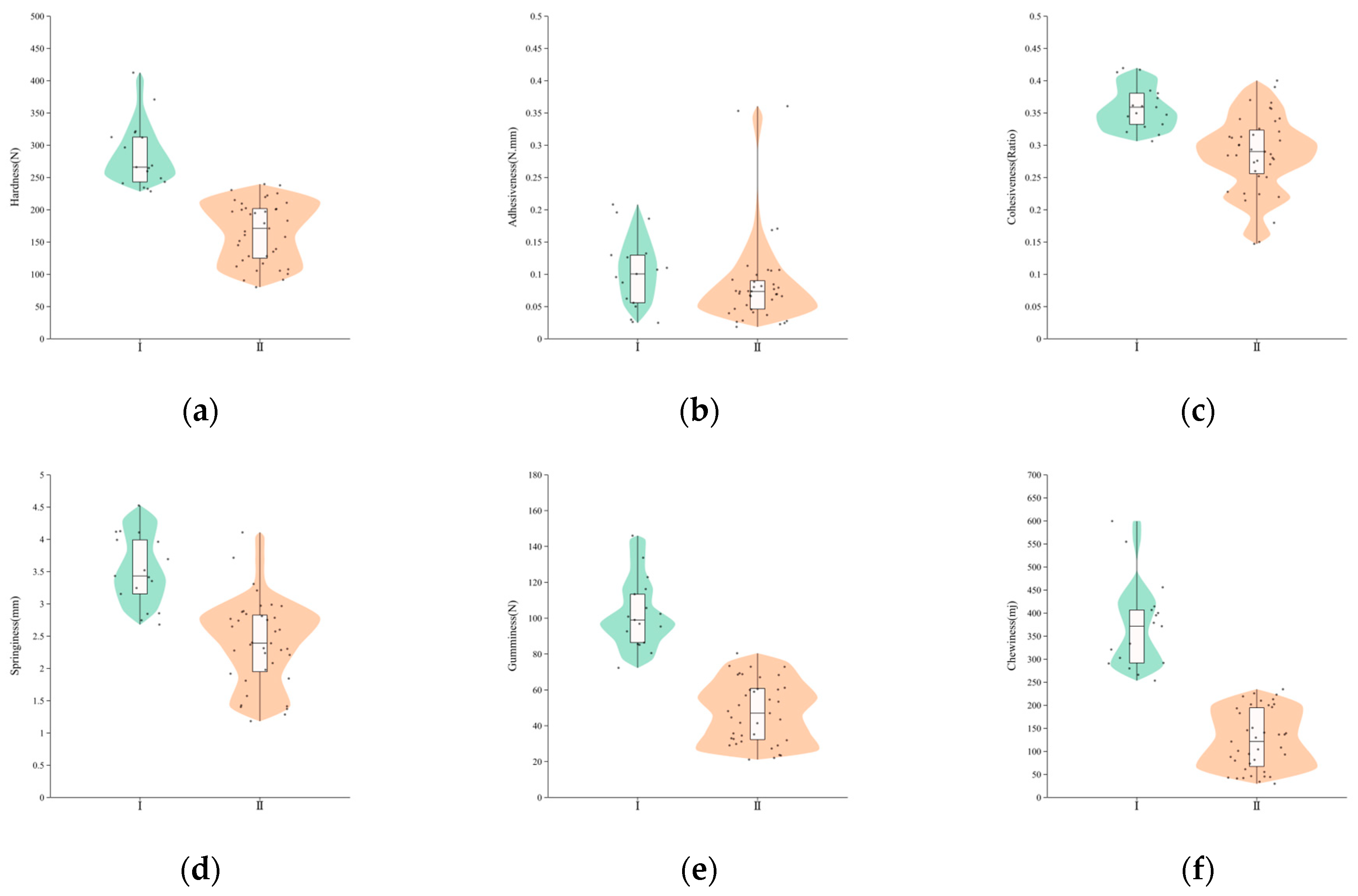
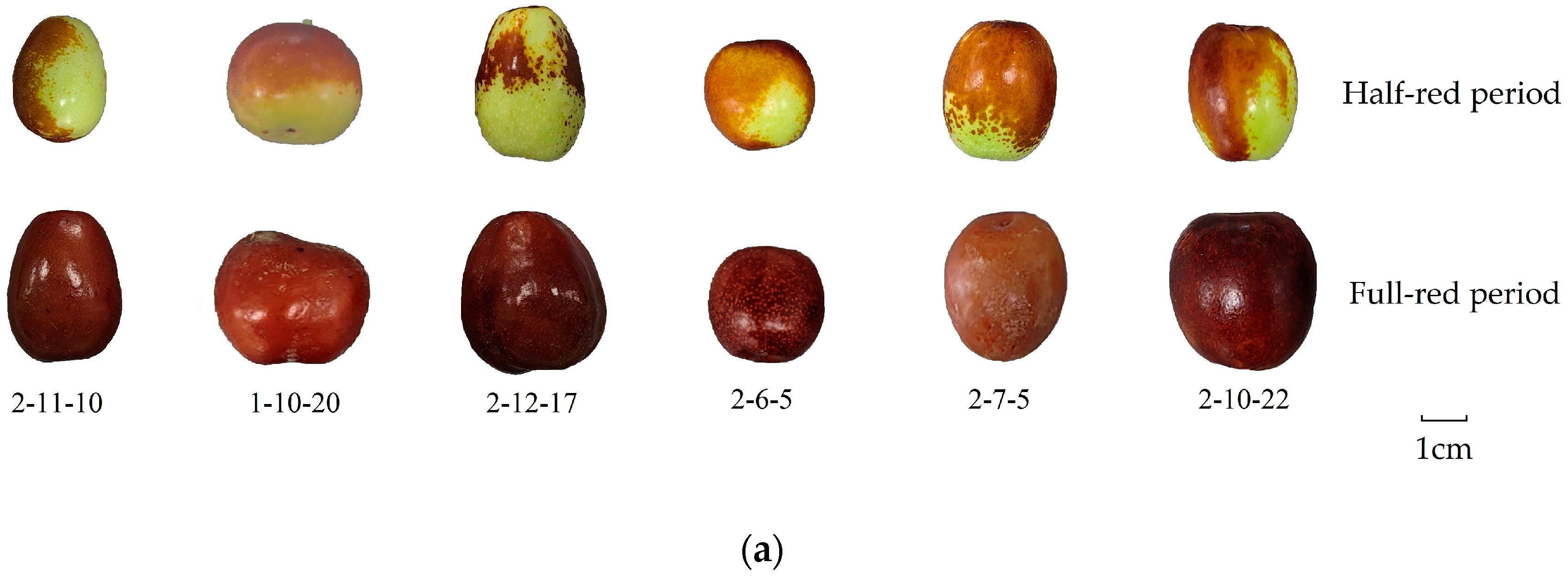
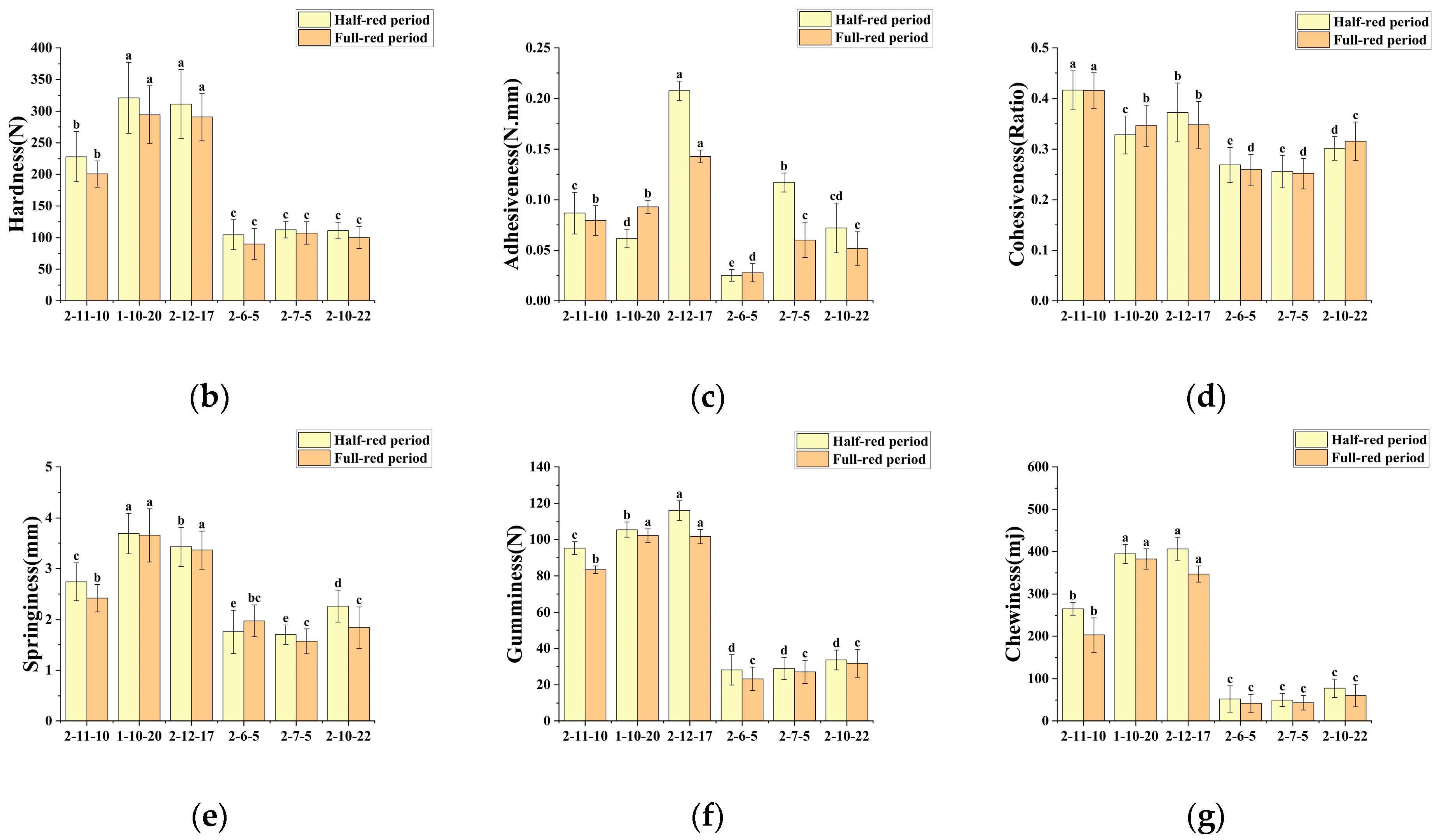
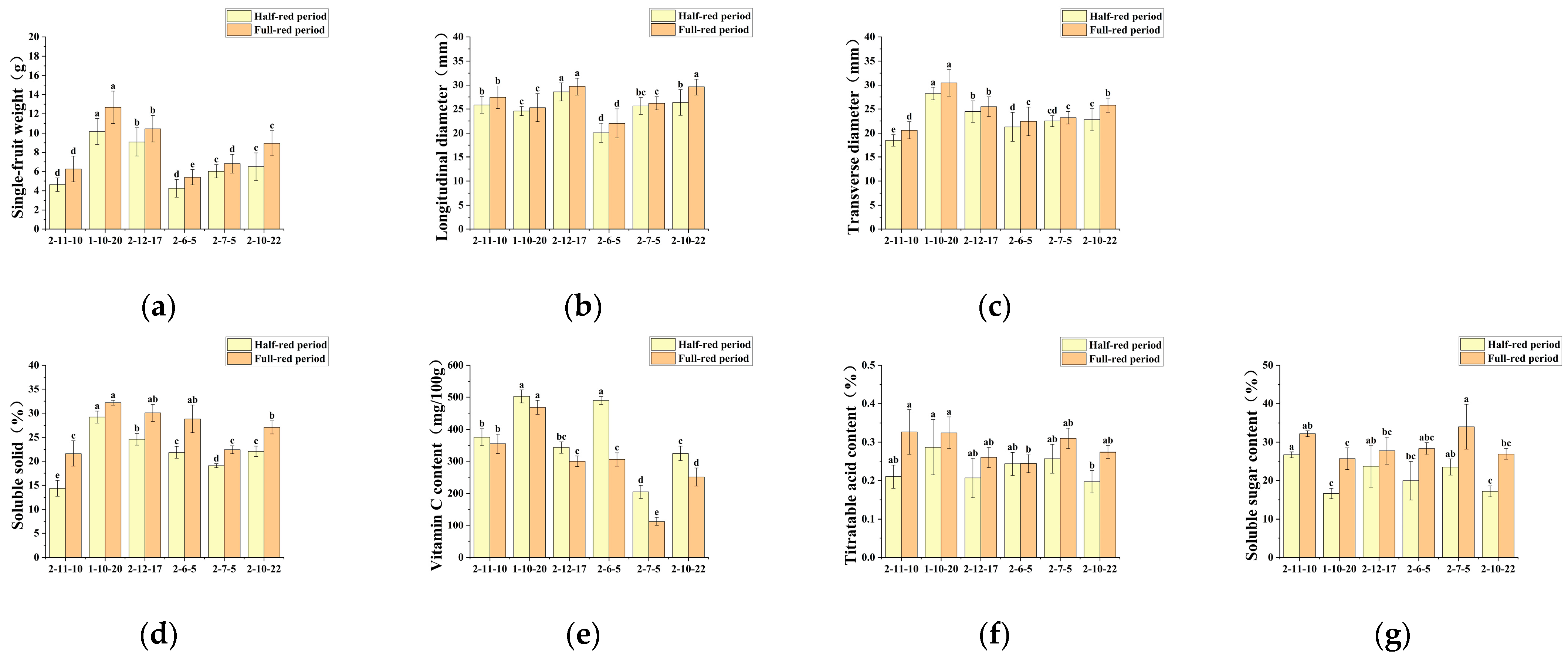
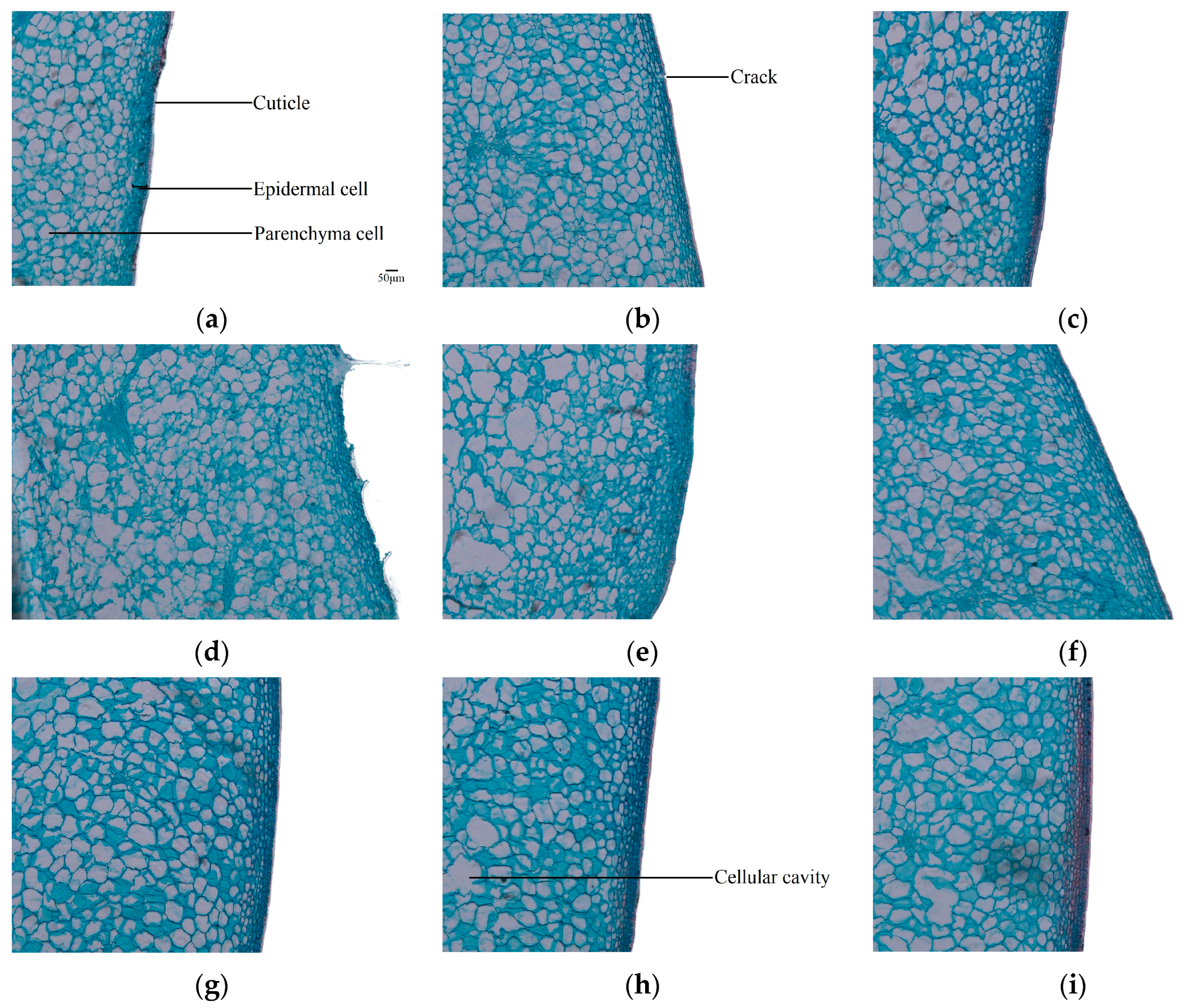

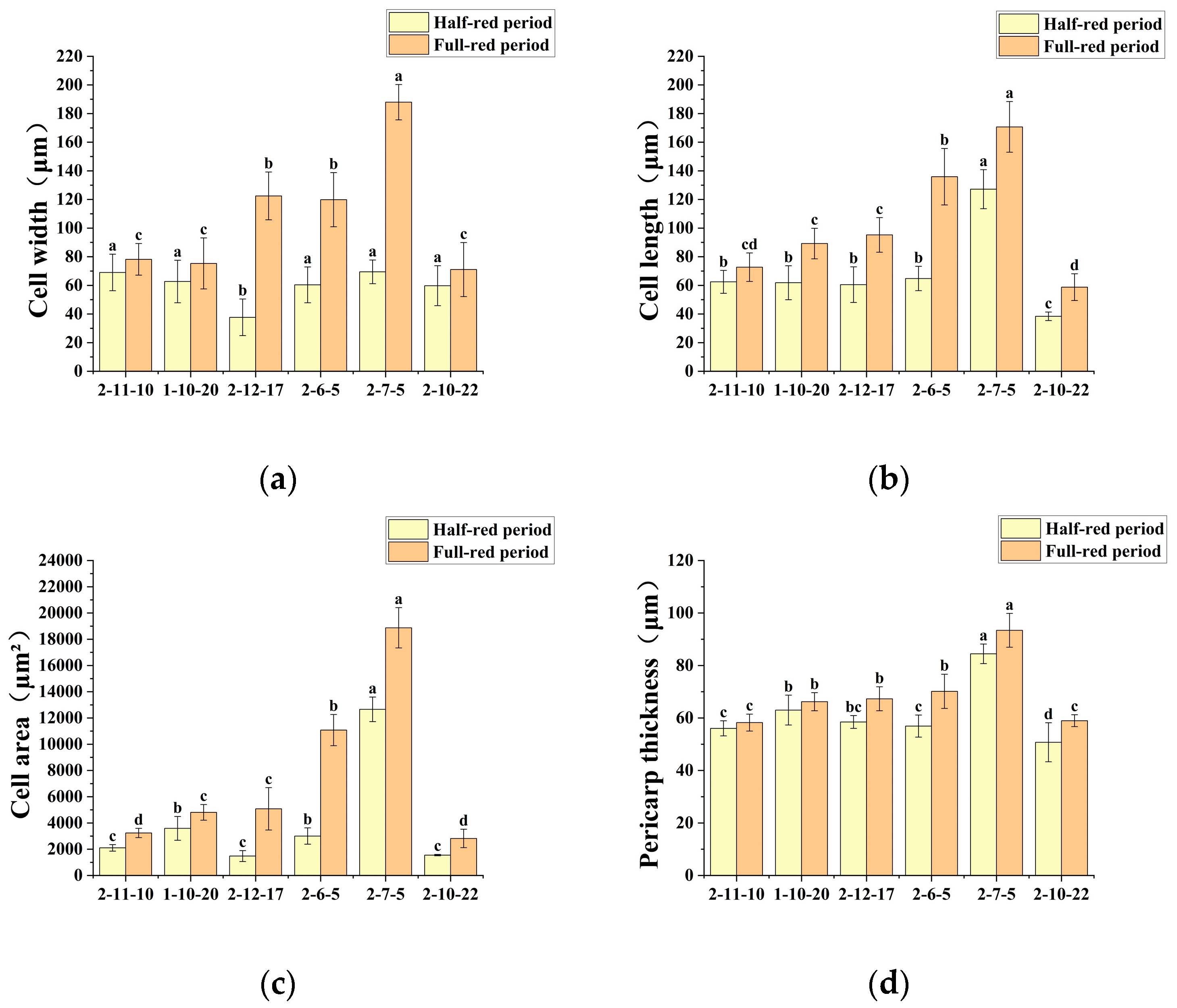
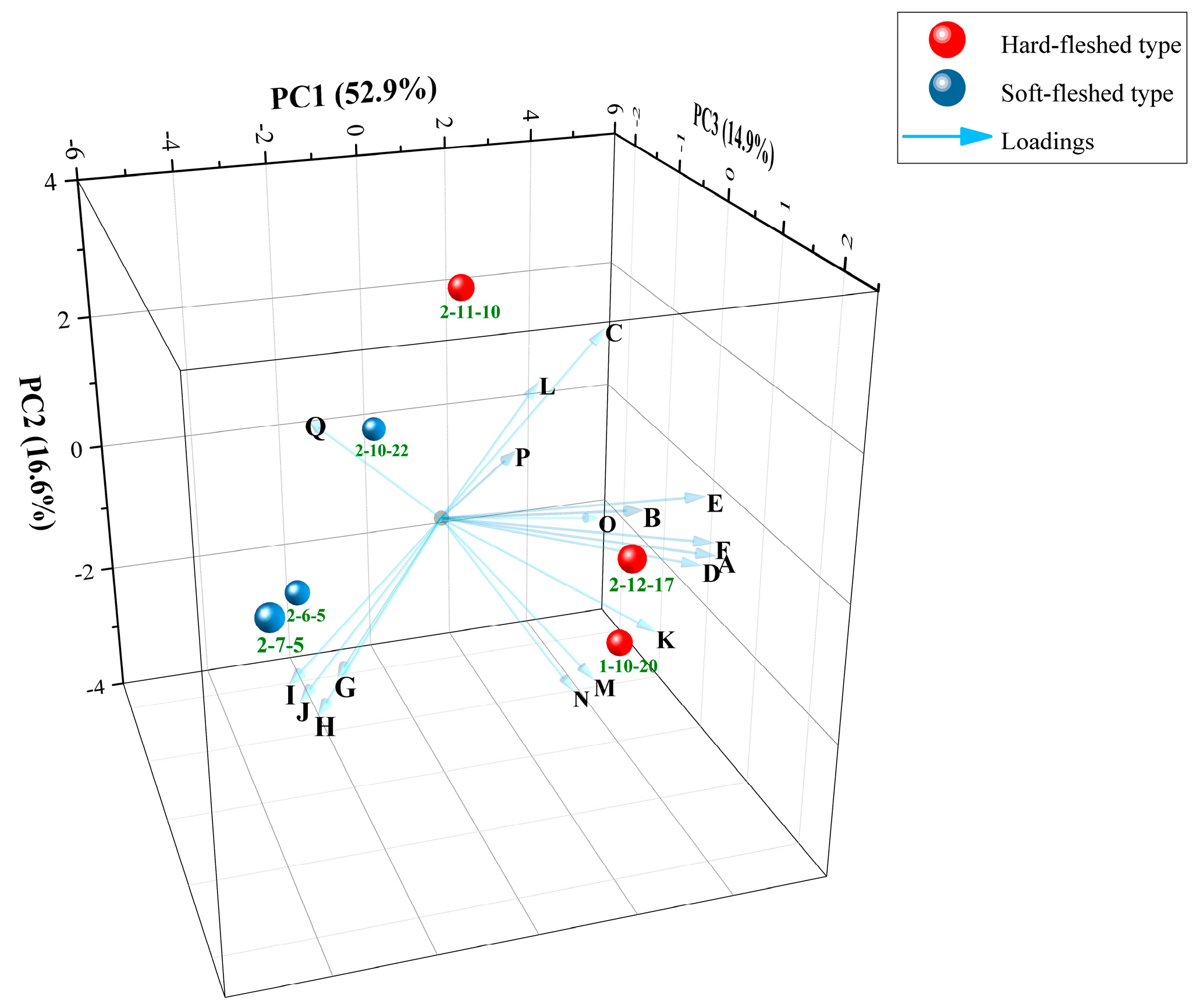
Disclaimer/Publisher’s Note: The statements, opinions and data contained in all publications are solely those of the individual author(s) and contributor(s) and not of MDPI and/or the editor(s). MDPI and/or the editor(s) disclaim responsibility for any injury to people or property resulting from any ideas, methods, instructions or products referred to in the content. |
© 2024 by the authors. Licensee MDPI, Basel, Switzerland. This article is an open access article distributed under the terms and conditions of the Creative Commons Attribution (CC BY) license (https://creativecommons.org/licenses/by/4.0/).
Share and Cite
Zhang, X.; Yan, M.; Sun, Y.; Zhou, X.; Yuan, Z.; Li, X.; Lin, M.; Wu, C. Textural Characteristics and Anatomical Structure of Hard- and Soft-Fleshed Jujube Fruits. Agriculture 2024, 14, 2304. https://doi.org/10.3390/agriculture14122304
Zhang X, Yan M, Sun Y, Zhou X, Yuan Z, Li X, Lin M, Wu C. Textural Characteristics and Anatomical Structure of Hard- and Soft-Fleshed Jujube Fruits. Agriculture. 2024; 14(12):2304. https://doi.org/10.3390/agriculture14122304
Chicago/Turabian StyleZhang, Xiaodong, Min Yan, Yongle Sun, Xiaofeng Zhou, Ze Yuan, Xiangyu Li, Minjuan Lin, and Cuiyun Wu. 2024. "Textural Characteristics and Anatomical Structure of Hard- and Soft-Fleshed Jujube Fruits" Agriculture 14, no. 12: 2304. https://doi.org/10.3390/agriculture14122304
APA StyleZhang, X., Yan, M., Sun, Y., Zhou, X., Yuan, Z., Li, X., Lin, M., & Wu, C. (2024). Textural Characteristics and Anatomical Structure of Hard- and Soft-Fleshed Jujube Fruits. Agriculture, 14(12), 2304. https://doi.org/10.3390/agriculture14122304





